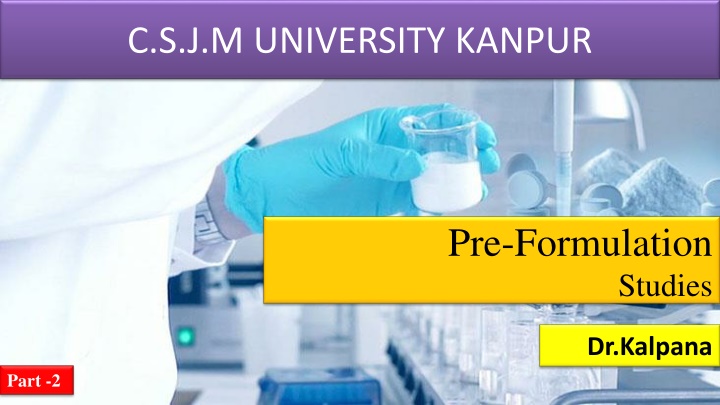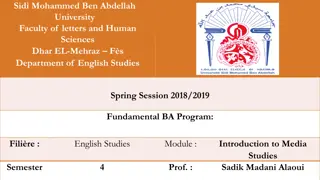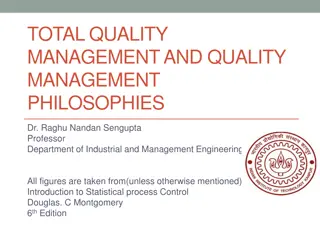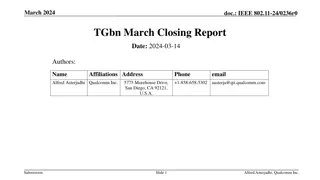Preformulation Studies at C.S.J.M. University Kanpur
Scientists at C.S.J.M. University Kanpur conduct preformulation studies before starting drug development. Key considerations include physicochemical data, route of administration, and stability analysis. Evaluated parameters cover physical and chemical characteristics, such as isomerization and solubility. Bulk characterization and polymorphism are also explored to understand the drug's properties. The study delves into physical properties, crystal habit, and crystalline structures, shaping the development process for new drugs.
Download Presentation

Please find below an Image/Link to download the presentation.
The content on the website is provided AS IS for your information and personal use only. It may not be sold, licensed, or shared on other websites without obtaining consent from the author.If you encounter any issues during the download, it is possible that the publisher has removed the file from their server.
You are allowed to download the files provided on this website for personal or commercial use, subject to the condition that they are used lawfully. All files are the property of their respective owners.
The content on the website is provided AS IS for your information and personal use only. It may not be sold, licensed, or shared on other websites without obtaining consent from the author.
E N D
Presentation Transcript
C.S.J.M UNIVERSITY KANPUR Pre-Formulation Studies Dr.Kalpana Part -2
What to consider before starting a preformulation study ? Scientists must think about a few things before starting preformulation investigations. Available physicochemical data, such as chemical structure, various salts, potency in comparison to competing products, and dose form, among other things. The proposed route of drug administration and the expected dose. Supply situation and development schedule. Availability indicating assay.
Evaluated Parameters in Preformulation studies Physical characteristics:- Organoleptic properties of the candidate drug molecule e.g., colour, odour and taste. Bulk characterization e.g., particle size and surface area, powder flow properties, density, compressibility, crystalline, polymorphism and hygroscopicity. Solubility analysis e.g., ionization constant/ drug Pka, partition coefficient, solubilization, thermal effect, common ion effect (Ksp) and dissolution. Stability analysis e.g., solution-state stability testing, solid-state stability testing, and drug-excipient compatibility studies.
Chemical characteristics Isomerization Hydrolysis Oxidation Polymerization Photostability Racemization
Physical Properties Organoleptic properties:- Colour,odour,taste of the new drug must be recorded. Colour Odour Taste Off-white Pungent Acidic Cream yellow Sulphourous Bitter Itan Fruity Bland Shiny Aromatic Intense Odurless Sweet Tasteless
Bulk Characterization Crystalline:- Crystal habit is description of outer appurtenance of crystal. Internal structure is molecules arrangement with in the solid. Crystal habit & Internal structure of drug can affected bulk & physiological properties of molecules. Change with internal structure usually alter crystal habit. Eg:-Conversion of sodium salt to its free acid produce both change in internal structure & crystal habit.
Different shapes Of Crystals Depending on internal structure compounds is classified as 1.Crysalline. 2.Amorphous.
Polymorphism It refers to a compound's ability to crystallize as multiple separate crystalline species with differing internal lattices. Polymorphs are different crystalline forms. There are two sorts of polymorphs. 1.Enatiotropic. 2.Monotropic. Enantiotropy polymorph is a type of polymorph that can transform from one state to another by altering temperature or pressure. for example:- Sulphur Monotropic polymorphs are polymorphs that are unstable at all temperatures and pressures. for example:- Glycerl stearate
Polymorphs differ from each other with respect to their physical property such as:- Solubility Melting point Density Hardness Compression characteristic. Eg. Chloromphenicol exist in A.B & C form of these B Form Is more stable & most Preferable
Particle Size Particle size is characterized using these terms:- Very coarse, Coarse, Moderately coarse, Fine ,Very fine. Particle size can influence variety of importance factors Dissolution rate Suspend-ability Uniform distribution Penetrability Lack of grittiness.
Method to determine Particle size Sieving (5u-15u) Microscopy (0.2u-100u) Sedimentation rate method (1u-200u) Light energy diffraction (0.5u-500u) Lesser holography (1.4u- 100u).
Powder Flow Properties Powder flow properties can be affected by change particle size, shape & density. The flow properties depend upon following- 1. Force of friction. 2. Cohesion b/w one particle to another. Fine particle posses poor flow by filling void spaces b/w large particle causing packing & desification of particles. By Using glident we can alter the flow properties Eg:- Talc
Determination of powder flow properties By determining Angle of Repose. A grater angle of repose indicate poor Flow. It should be less than 30 degree & can be determined by following equation.
Method to determine angle of Repose Static angle of repose. Fixed-funnel method Fixed-cone method Kinetic or dynamic method Rotating Cylinder method. Tilting box method.
Determination of powder flow properties Measurement of free flowing powder by compressibility. Also known as Carr s index It is simple. Fast & popular method of predicting powder flow characteristics.
Solubility Studies Solution phase equilibrium with solid phase at a stated temperature and pressure. Determination amount of drug dissolved. Amount of drug available for absorption. Solubility reduction is carried out in certain conditions. Enhancement of chemical stability. Taste masking products. Production of sustained release products.
The equilibrium solubility is based on the phase-solubility technique proposed by Higuchi-Connors. Method Drug dispersed in solvent in a closed container. Agitated at a constant temperature using shakers. Sample of the slurry are withdrawn as a function of time. Clarified by centrifugation and assayed by HPLC,UV,GC, etc.






















